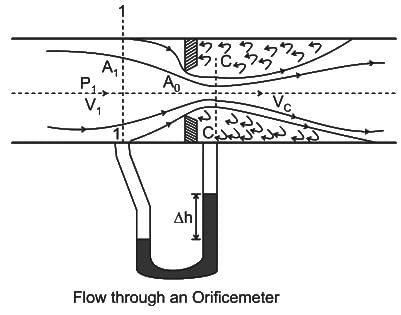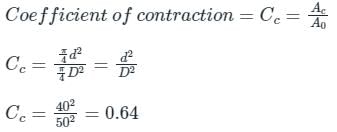Civil Engineering (CE) Exam > Civil Engineering (CE) Questions > If a fluid jet discharging from a 50 mm diame...
Start Learning for Free
If a fluid jet discharging from a 50 mm diameter orifice has a 40 mm diameter at its vena-contracta then its coefficient of contraction will be
- a)0.80
- b)0.90
- c)1.25
- d)0.64
Correct answer is option 'D'. Can you explain this answer?
Most Upvoted Answer
If a fluid jet discharging from a 50 mm diameter orifice has a 40 mm d...
Concept:
Orifice meter
Orifice meter

- An orifice meter is a thin plate with a centrally located hole is inserted into the flow passage.
- The flow contracts suddenly as the fluid passes through the hole. The flow continues to contract a short distance downstream the hole.
- The region of the smallest cross-section is known as vena contracta, which is developed downstream the orifice. At vena contracta the kinetic energy of the fluid flow is maximum.
- The minimum cross-section in the orifice meter is not orifice diameter but it’s cross-section at vena contracta.
Coefficient of contraction (Cc)
Coefficient of contraction (Cc) is defined as the ratio of the area of cross-section of vena contracta to the area of cross-section of the orifice.
Coefficient of contraction = Cc = Ac / A0
where Ac = area of vena-contracta, A0 = orifice area
Calculation:
Given:
Orifice diameter = 50 mm, diameter at vena contracta = 40 mm

Coefficient of contraction (Cc) is defined as the ratio of the area of cross-section of vena contracta to the area of cross-section of the orifice.
Coefficient of contraction = Cc = Ac / A0
where Ac = area of vena-contracta, A0 = orifice area
Calculation:
Given:
Orifice diameter = 50 mm, diameter at vena contracta = 40 mm

Free Test
FREE
| Start Free Test |
Community Answer
If a fluid jet discharging from a 50 mm diameter orifice has a 40 mm d...
Coefficient of Contraction in Fluid Mechanics
In fluid mechanics, the coefficient of contraction is a dimensionless parameter that represents the ratio of the area of the vena contracta to the area of the orifice through which the fluid is discharging. It is denoted by the symbol Cc.
Given:
Diameter of orifice (Do) = 50 mm
Diameter of vena contracta (Dc) = 40 mm
To find the coefficient of contraction, we can use the formula:
Cc = (Dc / Do)^2
Substituting the given values:
Cc = (40 mm / 50 mm)^2
Simplifying the expression:
Cc = (0.8)^2
Cc = 0.64
Therefore, the correct answer is option 'D' (0.64).
Explanation:
The coefficient of contraction is a measure of the contraction of the fluid stream as it passes through the orifice. It represents the reduction in cross-sectional area of the fluid jet at the vena contracta compared to the orifice.
In this case, the diameter of the orifice is 50 mm, while the diameter of the vena contracta is 40 mm. To calculate the coefficient of contraction, we need to find the ratio of these two diameters.
Using the formula for the coefficient of contraction, we square the ratio of the diameters:
Cc = (40 mm / 50 mm)^2
Cc = (0.8)^2
Cc = 0.64
Therefore, the coefficient of contraction is 0.64.
Conclusion:
The coefficient of contraction for a fluid jet discharging from a 50 mm diameter orifice with a 40 mm diameter vena contracta is 0.64. This means that the area of the vena contracta is approximately 64% of the area of the orifice.
In fluid mechanics, the coefficient of contraction is a dimensionless parameter that represents the ratio of the area of the vena contracta to the area of the orifice through which the fluid is discharging. It is denoted by the symbol Cc.
Given:
Diameter of orifice (Do) = 50 mm
Diameter of vena contracta (Dc) = 40 mm
To find the coefficient of contraction, we can use the formula:
Cc = (Dc / Do)^2
Substituting the given values:
Cc = (40 mm / 50 mm)^2
Simplifying the expression:
Cc = (0.8)^2
Cc = 0.64
Therefore, the correct answer is option 'D' (0.64).
Explanation:
The coefficient of contraction is a measure of the contraction of the fluid stream as it passes through the orifice. It represents the reduction in cross-sectional area of the fluid jet at the vena contracta compared to the orifice.
In this case, the diameter of the orifice is 50 mm, while the diameter of the vena contracta is 40 mm. To calculate the coefficient of contraction, we need to find the ratio of these two diameters.
Using the formula for the coefficient of contraction, we square the ratio of the diameters:
Cc = (40 mm / 50 mm)^2
Cc = (0.8)^2
Cc = 0.64
Therefore, the coefficient of contraction is 0.64.
Conclusion:
The coefficient of contraction for a fluid jet discharging from a 50 mm diameter orifice with a 40 mm diameter vena contracta is 0.64. This means that the area of the vena contracta is approximately 64% of the area of the orifice.

|
Explore Courses for Civil Engineering (CE) exam
|

|
Similar Civil Engineering (CE) Doubts
Question Description
If a fluid jet discharging from a 50 mm diameter orifice has a 40 mm diameter at its vena-contracta then its coefficient of contraction will bea)0.80b)0.90c)1.25d)0.64Correct answer is option 'D'. Can you explain this answer? for Civil Engineering (CE) 2025 is part of Civil Engineering (CE) preparation. The Question and answers have been prepared according to the Civil Engineering (CE) exam syllabus. Information about If a fluid jet discharging from a 50 mm diameter orifice has a 40 mm diameter at its vena-contracta then its coefficient of contraction will bea)0.80b)0.90c)1.25d)0.64Correct answer is option 'D'. Can you explain this answer? covers all topics & solutions for Civil Engineering (CE) 2025 Exam. Find important definitions, questions, meanings, examples, exercises and tests below for If a fluid jet discharging from a 50 mm diameter orifice has a 40 mm diameter at its vena-contracta then its coefficient of contraction will bea)0.80b)0.90c)1.25d)0.64Correct answer is option 'D'. Can you explain this answer?.
If a fluid jet discharging from a 50 mm diameter orifice has a 40 mm diameter at its vena-contracta then its coefficient of contraction will bea)0.80b)0.90c)1.25d)0.64Correct answer is option 'D'. Can you explain this answer? for Civil Engineering (CE) 2025 is part of Civil Engineering (CE) preparation. The Question and answers have been prepared according to the Civil Engineering (CE) exam syllabus. Information about If a fluid jet discharging from a 50 mm diameter orifice has a 40 mm diameter at its vena-contracta then its coefficient of contraction will bea)0.80b)0.90c)1.25d)0.64Correct answer is option 'D'. Can you explain this answer? covers all topics & solutions for Civil Engineering (CE) 2025 Exam. Find important definitions, questions, meanings, examples, exercises and tests below for If a fluid jet discharging from a 50 mm diameter orifice has a 40 mm diameter at its vena-contracta then its coefficient of contraction will bea)0.80b)0.90c)1.25d)0.64Correct answer is option 'D'. Can you explain this answer?.
Solutions for If a fluid jet discharging from a 50 mm diameter orifice has a 40 mm diameter at its vena-contracta then its coefficient of contraction will bea)0.80b)0.90c)1.25d)0.64Correct answer is option 'D'. Can you explain this answer? in English & in Hindi are available as part of our courses for Civil Engineering (CE).
Download more important topics, notes, lectures and mock test series for Civil Engineering (CE) Exam by signing up for free.
Here you can find the meaning of If a fluid jet discharging from a 50 mm diameter orifice has a 40 mm diameter at its vena-contracta then its coefficient of contraction will bea)0.80b)0.90c)1.25d)0.64Correct answer is option 'D'. Can you explain this answer? defined & explained in the simplest way possible. Besides giving the explanation of
If a fluid jet discharging from a 50 mm diameter orifice has a 40 mm diameter at its vena-contracta then its coefficient of contraction will bea)0.80b)0.90c)1.25d)0.64Correct answer is option 'D'. Can you explain this answer?, a detailed solution for If a fluid jet discharging from a 50 mm diameter orifice has a 40 mm diameter at its vena-contracta then its coefficient of contraction will bea)0.80b)0.90c)1.25d)0.64Correct answer is option 'D'. Can you explain this answer? has been provided alongside types of If a fluid jet discharging from a 50 mm diameter orifice has a 40 mm diameter at its vena-contracta then its coefficient of contraction will bea)0.80b)0.90c)1.25d)0.64Correct answer is option 'D'. Can you explain this answer? theory, EduRev gives you an
ample number of questions to practice If a fluid jet discharging from a 50 mm diameter orifice has a 40 mm diameter at its vena-contracta then its coefficient of contraction will bea)0.80b)0.90c)1.25d)0.64Correct answer is option 'D'. Can you explain this answer? tests, examples and also practice Civil Engineering (CE) tests.

|
Explore Courses for Civil Engineering (CE) exam
|

|
Signup to solve all Doubts
Signup to see your scores go up within 7 days! Learn & Practice with 1000+ FREE Notes, Videos & Tests.



























